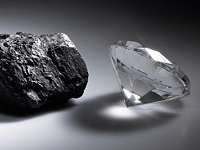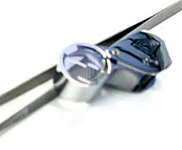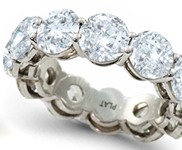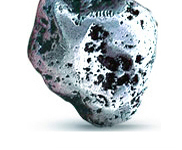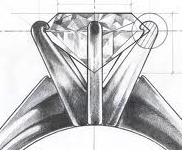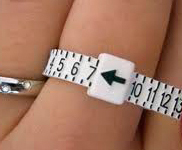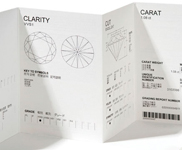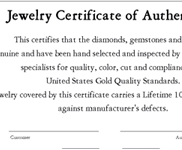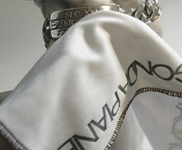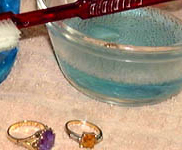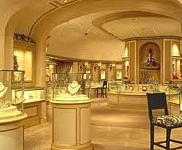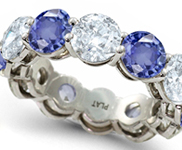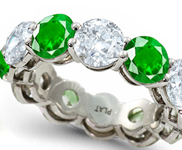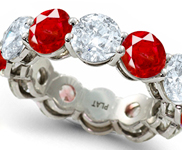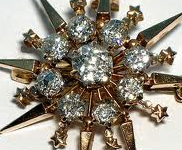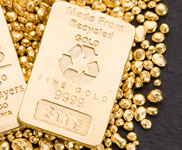Every gemstone has its own unique identity and genuine gemstone identification is a process that involves identifying gemstones structure and chemical properties. Genuine gemstone identification requires gemological knowlege, gemology tools and a well trained experience eye. There are many ways to identify a real gem from a fake one.
With new technology synthetic and imitation gemstones have flooded the jewelry market. Synthetic and imitation gemstones have a market in cheap imitation jewelry as they are affordabile, stunnig color and there is unlimited supply. As a result genuine gemstone identification has become much more important now a days as it is difficult to differentiate between genuine and fake gemstones. For people seeking quality and value and invest lot of money it is almost essential to learn about genuine gemstone identification process. Especially buying jewelry online trust is the biggest factor so everyone in seach for fine quality gemstone jewelry should get themselves aquainted with this process. If you are a gem dealer or jeweler you for sure need to be able to accurately evaluate the exact value of the gemstones and know if they are genuine or synthetic stones. Gemstone Appraisals for insurance value are bt law required to disclose gemstone treatments and enhancements, and in order to provide this information you will have to be able to identify gemstones genuineness, grade, value and and if any treatments gave been done. First we need to learn about gemstones and once we are familiar with gemstones then by observation and with the help of magnification tools you can identifying a gemstone.
Determinative identification skills may take many years to develop, and may
involve the use of an array of expensive equipment for measuring everything from
density to various optical properties or even thermal conductance.
Confirmative identification of gems is much easier to learn and may
often be accomplished with few simple tools and your eyes. Know we'll talk about confirmative gemstone identification.
1: Gemstone Knowledge & Observation:
Gemstones identification can be made easier by using the unaided eye and 10 power magnification in determining the visible gemstone characteristics. By doing this you will be able to properly identify gemstones. First we need to know about gemstones tone, hue, saturation, dispersion and transparency.
In order to properly visually analyze a gemstone we need set up an area where we should use neutral colored background with proper lighting. We'll need some basic jewelry supplies like a gemstone cleaning cloth, incandescent lighting, ultra violet lighting, daylight equivalent lighting, a 10 magnification loupe and tweezers.
Gemstones Optical Properties
Gemstone Color: Color is the most important charaterstic of a gemstone. In gemstone identification color is not the diagnostic in most of the cases as many stones have the same color. Color is produced by light as it is elctromagnetic vibration at certain wavelengths. Depending upon the wavelength picked or absorbed out of the entire spectrum, the remaining mixture produces a certain color. The metals and their combinations especially chrome, iron, cobalt, copper, manganese, nickel and and vanadium, absorb certain wavelengths of light and cause coloration. Pick up a stone in question and hold it up very close to your eye so that you
can look into the table. You must hold it very close without touching - almost
like inserting a contact lens, but again not touching. Look literally through
the stone at a distant source of light such as a lamp or light bulb. You will
see a number of reflections of the distant light source as they bounce around
within the stone. Carfully look at the stone to determine what stone color hue and the stones color tone level ranging from very light to very dark. Color comparison charts showing the range of hues found in colored gemstones will be helpful to use when determining the correct hue seen in a particular stone.
Gemstone Color of Streak: The colors of gems in the same group can vary geatly. A beryl can have all the colors of spectrum but can be colorless also. This colorness is the true colors and helps in gemstone identification.
Gemstone Transparency: A factor in the evaluation of most gemstones is their transparency. Inclusions of forein matter and air bubbles in the interior of crystal effect the transparency. Grainy or fibrous aggregartes are opaque because rays of light are refracted.
Gemstone Color Change: The color of gemstones is altered over time. Generally color changes by natural effects is not common.
Light & Gemstones Color Effects: Many gemstones show light effects or color effects which do not relate to their color and not because of impurities or chemical composition. These effects are caused by reflection, interferance and refraction. These types of light or color effects will appear as sparkling, shimmering, glowing, and color change. Knowing what type of light and color effects is occurring in a gemstone can help in gemstone identification. Common light and color effects are adularascence, asterism, aventuriazation, chatoyancy, iridescence, and color change. This effects makes the stones more desirable in that they add such a rare beauty and captivating effect to a gemstones overall look.
Gemstone Luster: The luster of a gem is caused by reflection. It is dependent on the refractive index and the nature of surface but not on color. The higher the refraction, When judging luster reflect light off of the area of the stone that has the been polished well. The most desirable luster is admantine to vitreous and the most undesired luster is greasy, silky, waxy lusters. The lower facets strengthens lustrous appearance.
Gemstone Dispersion: A play of color which comes about through dispersion of the white light into spectral colors. The dispersion is different from one gemstone to another. Color gemstones tends to mask the dispersion effection and will help in gemstone identification. Dispersion is measured by a refractometer and other devices. Diamonds have the highest color dispersion so called fire and it helps identifying diamonds from its simulants. Dispersion is an important factor in gemstone identification. Dispersion tables can be used in identification of a gemstone. The strength of a stones fire play will help you determine the what kind of stone you have.
Gemstone Weight: The weight of a stone compared to its size can also help in gemstone identification as fake stones weight more or less.
Gemstone Double Refraction: In some gemstones ray of light is refracted when entering the crystal and at the same time divided into two rays and this phenominan is called double refraction. The double refraction can be useful in gemstone identification. It is expressed as the difference between highest and lowest refractive index.
2: Gemology Testers
Gemologists use Gemology Testers to accurately find a real gem from a fake one. Every gemstone mineral species have their own unique optical and physical properties, scientific data is needed to prove these properties in order to make a positive identification. The process involves first in determining gemstones optical and physical properties and then to relate to which mineral species they belong to. This process requires several gemological tests that need to be performed.
There are many geomology testers so a good knowledge of gemology testing equipment will help you a lot in accurately indentify gemstones. The most import thing in gemstone identification is to keep your gemstone clean and free of lint and oils using the gemstone cloth. This will provide more accurate results during gemstone identification testing. Some of the most important test to conduct will be using the microscope and loupe, refractometer for refractive index, Chelsea filter, and a polariscope.
Microscope: A gemological microscope is the microscope used by
jewelers and gem stone experts. These microscopes are especially created to view
precious stone samples and the pieces of jewelry that contain them. The proper
ways of using gemological microscopes are on the article below:
Gemological microscopes are usually used to
inspect the authenticity of gemstones and in the design, creation, and repair of
jewelry. And because these microscopes are used with items of value, it is
important that these would be used properly to enhance their
usefulness.Here are the steps on how to properly use
gemological microscopes:
1. Place the
microscope on a flat surface.
When using
gemological microscopes, or any type of microscope for that matter, always make
sure that it is placed on a leveled surface before starting any observation
tasks. Make sure that the microscope is far from any water source as well. When
using the microscope, use a table or a chair that matches your height as its
user. That way, you won’t be straining your back while looking at the
sample.
2. Prepare the
microscope for first line calibration.
After
setting the gemological microscope on its proper place, calibrate its focus
using the lowest objective available. Most gemological microscopes have a single
objective lens, although it is capable of several magnification levels. Make
sure that the microscope is set at the lowest level. Look through the eyepiece
and make sure everything is aligned and in order. You might also want to check
the manual to aid you in this process.
3. Place the
sample on the stage.
A gemological microscope
has a special stage. Its stage is capable of holding gemstones regarding of
their cut. Empire cut type of stone is most accommodated. Set the precious stone
you are going to observe properly at the center of the stage. There would be
controls for the stage’s holder. Use it accordingly.
A gemological microscope also comes with
different holders for use with gemstones. There are holders available for wire
stones and stones with rounded edges. For larger gems, a stage plate can be
used.
4. Choose with
light source to use.
Most gemological
microscopes are equipped with three different light sources namely bright field,
dark field, and incident fluorescent illumination systems. Bright field is the
most common type of an illumination system. With it, you will be able to inspect
the gemstone against a white background. This is perfect for gemstones of darker
color.
The dark field illumination system is the
opposite of the bright field illumination system. This lighting technique would
produce an image of the specimen against a dark background. It is perfect for
rubies and emeralds. It is the best technique used if the shape of the gemstone
is of primary concern.
The incident fluorescent illumination system
produces reflected light on the sample. As such, it is perfect to inspect the
clarity and color of diamonds. The fluorescent light that is used in this type
of an illumination system is perfect for this application because fluorescent
lights don’t put any light stains on the sample under observation.
5. Focus on the
gemstone.
Use the different magnification power
available on the microscope. There are also auxiliary objectives that can be
used with the system, ranging from 1.5x to 2x magnification levels. There are
also auxiliary eyepieces. The standard is usually 1x but there are 10x, 15x, and
20x eyepieces available in the market today. Use the right objective-eyepiece
combination for optimum results. These microscopes are also equipped with knobs
for fine and coarse focusing. It is also possible to control the intensity of
the light source. Learn what the knobs found in the microscope are for and used
them as intended.
Gemological microscopes may also have rotary
and tilting bases. These are going to be helpful in focusing on the specimen
more. Change the angle of inclination of the base from the arm so that the sides
of the specimen can be observed as well.
These are the steps on how to properly use
gemological microscopes. Follow these steps so that you will be able to properly
observe precious gems without compromising their value. And by doing all of
these, the safety and functionality of the microscope will be
ensured.Gem stone experts need one important tool in
their jobs. And that would be a precision microscope that is capable of
inspecting diamonds, emeralds, rubies, and all other types of precious stones.
These microscopes are complex microscopes that are equipped with multiple
illumination systems to enhance the image of the samples.
Jewelry Loupe: Loupe is used to
detect chips, cracks, scratches, sharpness of edges, symmetry in cutting,
presence and types of flaws. The 10x triplet jewlers loupe is an essential tool
to own.
Instructions on how to use these 3 simple tools to identify
gemstones are included. Using a 10 power loupe is a requirement in stone identification, one with a triplet lens will make it easier to use the loupe. Get yourself acquainted with using a loupe and a tweezers at the same time, it is important to be able to quickly pick up a stone and view it under a loupe. A loupe will help in finding important information about the stone such as doubling, surface characteristics, and inclusions.
Jewelry Refractometer: Each type of gem has its own refraction index, a measurement calculated with
a refractometer.
The instrument can help you identify what kind of gem or stone you have.
Refraction
When light travels through an object,
it bends, or is refracted at an angle. It changes both directions and speed, and
you can measure the refraction to determine the angle. Reflection is another
measurement of light, which is the light that bounces off the surface of a gem.
Each gemstone has its own refractive index, which is a number that represents
the angle that the light is refracted at for that gemstone. You can use the
refractive index to identify different kinds of gems. Refractometer measure
a refractive index up to 1.81 usually, which can exclude some higher stones like
diamonds.
Birefringence
Materials with a crystal lattice
formation can exhibit birefringence. This means that as the light passes through
the gem, it splits, and one part is refracted while the other passes straight
through. An example of a gem that would show this would be quartz. Almost all
refractometers can measure this, which will give a more accurate refractive
index for the gem.
Refractive Index
The refractive index is a
calculation involving both the incident angle and the refractive angle. The
incident angle is the light's angle as it enters the gem, and the refractive
angle is the angle that light bends at once it is inside the gem. The ratio
between the two angles will equal the refractive index, which is different for
each mineral.
Gem Identification
A refractometer measures the
refractive index of the gem. You use refractive index liquid to eliminate air
between the refractometer and the gem so the light will pass straight into the
stone. The refractometer shines the light through the stone, and you can see it
on a scale through the eyepiece. There are many other tests that determine the
type of gem without a refractometer. You can test hardness, color, and
morphology of the stone, all of which will help you get an even clearer view of
what you have.
Alternative Meters
In addition to refractometers
utlilized for gem identification, there are also gem filters and
reflectivity meters. Gem filters are the least expensive. When looking at a
gemstone through a gem filter, you will only see certain colors of the light,
which will help to identify the stone. Reflectivity meters measure the
reflectivity of the stone rather than the refraction index. This is less exact
than refractometers, but is still very useful in identifying gems. Lastly, there
are gem testers that measure thermal conductivity of stones. You can use them on
more types of stones than refractometers or reflectivity meters.
This is THE standard tester for gem testing. It is optical (not electronic), you see a shadow on a scale, read the number, then look it up on standard charts. Can be used with any gemstone that has a flat polished surface, whether loose or set in jewellery (click MORE to see a picture of testing a mounted stone). Note: will not test for diamond.
Supplied in a sturdy box (easily portable) complete with a bottle of refractometer fluid.
Instructions are NOT included with this item, it is assumed that you are either a gemmologist (or a student) or that you will be using a book about gemmology.
Jewelry Polariscope: A polariscope is a gemological instrument that
tests for a gemstone being double or single refractive, and will allow us to
find the various crystal axis of the stone. Which is where is got its name:
Polar-scope..the a scope to see the poles or axis of the stone. Now, if you
remember the section on the dichroscope, the use of plane
polarized light allows us to see the different colors of light being
transmitted by a gemstone. The polariscope, however, allows us to actually see
the path that those beams are taking through the stone. By knowing that the
stone is double refractive, we can use the optic interference
figure to actually find the various optical directions that the light is
traveling through the stone, and thereby make identifications based on this
information.What it detects: double refraction.
How to use: At the top and bottom of the tube are two filters (Polaroid discs), revolve the top filter until everything in the tube appears dark and place the stone on the platform in the middle (if mounted, you might have to fix the item upright with a spot of blu-tac so that you can see the stone). Now turn the platform so that the stone revolves through 360°.
What you see: If the stone appears to turn light-and-dark it is doubly refractive, if it remains dark it is singly refractive.
For the gemmologist: all crystalline gemstones except for those of the Cubic System are doubly refractive.
For the non-gemmolgist: Moissanite is strongly doubly refractive, diamond is singly refractive. This is, therefore, a very simple and effective method of distinguishing diamond from Moissanite. Instructions: not included.
Dichroscope: The dichroscope is another popular tool, which,
like the Chelsea filter, is considered invaluable for distinguishing certain
stones from similar gems. It can only be used on stones that are transparent and
are able to transmit light. It is used to differentiate between and identify
stones with similar colors. When looking through the dichroscope, the user
should see two squares/rectangles, side by side. When viewing a stone, the user
will see that it is either a single or a double refracting stone. What this
means is that if the same color and the same shade is visible in both
squares/rectangles, then the stone is single refracting. If the two boxes have
varying colors/shades, then the stone is a double refracting stone, or a
dichroic stone. Sometimes, depending on the angle/direction of the light, a
stone may have three colors, meaning when a pair of colors is seen through the
dichroscope, and the direction at which the stone is being viewed changes, one
of the original colors is replaced with a new color, resulting in a total of
three colors; this is called a trichroic stone.
Andalusite - Yes (trichroism)
Apatite - Yes, weak
Beryl - Yes, but usually weak
Chrysoberyl - Yes, but usually weak
Danburite - Yes, weak
Diopside - Yes, weak
Garnets - No (occasionally a color change Garnet will show an anomaly)
Iolite - Yes
Opal - No
Orthoclase - No
Peridot - Yes, but very weak
Quartz - No
Sapphire - Yes
Scapolite - Yes
Spinel - No (I have seen a couple that were color change and show an anomaly)
Sphene - Yes
Spodumene - Yes (Kunzite, Hiddenite...)
Tanzanite - Yes
Tourmaline - Yes
Topaz - Yes
Zircon - Yes
Ultra Violet Light Source: A gems reaction to UV (Ultra Violet) light will determine if it contains fluorescence or phosphorescence. In some cases the strength and the color of the fluorescence will be a great indicator of the stone species or if it’s genuine or synthetic material. UV light sources are available in smaller and more affordable hand held models or in larger type models that have the option of controlling the amount of energy with short wave and long wave settings. Keep stones clean and free of lint and oils by using a lint free gem cloth, the presence of these can affect the stones fluorescence.
The table below shows the colors of majority gemstones under UV
lights (SW/LW), and X-ray fluorescent light.
| Fluorescence of Common Gemstone |
| Gem |
LW Ultraviolet
Fluorescence Color |
SW Ultraviolet
Fluorescence Color |
X Ray Fluorescence
Color |
| Ruby |
Orange, Yellow, Blue,
Violet,Green |
Orange,Yellow, Blue, Green,
Violet |
White,Yellow, Green,
Blue |
| Sri Lanka
Sapphire |
Red |
Red |
Red |
| Sri Lanka Yellow
Sapphire |
Orange |
Orange |
Orange |
| Synthetic Orange
Sapphire |
Red,Orange |
Red,Orange |
Red |
| Synthetic Green
Sapphire |
Red,Orange |
Orange |
|
| Colorless
Sapphire |
Orange |
Orange |
Red |
| Ruby Spinel |
Red,Orange |
Orange |
Red,Orange |
| Synthetic Imitation
alexandrite corundum |
Red |
Red |
Red |
| Emerald |
Red,Green |
Red |
Red |
| Topaz |
Orange, Yellow |
|
Orange |
| Alexandrite |
Red |
Red |
|
| Apatite |
Yellow,Green,Violet |
|
|
| Zircon |
Yellow |
Yellow |
Yellow,Violet,Blue |
| Danburite |
Blue |
Blue |
Violet |
| Flourite |
Blue,Violet |
Blue,Violet |
Violet |
| Moonstone |
Blue |
|
Blue |
| Scapolite |
Orange,Violet |
Orange,Violet,Blue |
Orange |
| Diopside |
Violet |
|
|
| Kunzite |
Orange |
|
|
| Sodalite |
Orange spots |
|
Yellow,Blue |
| Lapis
Lazuli |
Orange spots |
Orange,Violet |
Yellow,Blue |
| Colored
Glass |
Yellow,Green,Blue |
Yellow,Green,Blue |
Blue(some) |
Spectroscope: A spectroscope was an early instrument for visually studying dispersed light.
These devices included either a prism or diffraction grating for dispersing the
light, telescopes for viewing narrow regions of the dispersed light, and
protractors or other calibrated scales for measuring the position of a narrow
region. Each gem has its own distinct way of how it absorbs light; a spectroscope is used to identify each stones unique spectrum pattern. A stones chemical composition and crystal structure will determine what part of visible light it will absorb influencing the color of the stone. Absorption spectrums usually consist of dark lines or bands and dark areas referred to as a cutoff. The placement of these lines and bands on the scale which represents the range of visible light will help determine the mineral species the stone belongs to. The spectroscope is used to analyze light passing through a stone. White light
is a combination of all the colors of the visible spectrum: red, orange, yellow,
green, blue, indigo, and violet. This is the rainbow we see when light travels
through a prism. When white light travels though a stone, one or more of the
wavelengths that produce color are absorbed by the gem. The colors that are NOT
absorbed are the colors seen when we look at the stone.
The wavelengths
that are absorbed by the stone are seen in the spectroscope as vertical black
lines in the spectrum. Each stone has a unique absorption spectrum (like a
fingerprint of the stone) When identifying a stone we look for a spectrum that
is characteristic for that stone.
The wavelengths that are absorbed by
the stone are seen in the spectroscope as verticle black lines in the spectrum.
Each stone has a unique absorption spectrum (like a fingerprint of the stone)
When identifying a stone we look for a spectrum that is characteristic for that
stone.
Below is a quick reference of simulated absorption spectrums for
common gemstones. There are many different signature spectrums within each type
of gem depending on locality, depth/saturation/hue of color, and of course the
specific chemical impurities that happen to affect the gemstone's color. This
quick reference gives you a generic idea of what light frequencies will be
absorbed for each gemstone.
Color Filter: Some gemstones appear to change colour when viewed through the Chelsea Colour Filter. This colour change helps identify many gemstones, distinguishing ruby from paste; distinguishing garnet (though not all garnets) emerald and aquamarine from paste. The Chelsea Filter also distinguishes many manmade stone such as cobalt-blue glass and blue synthetic spinel from natural blue stones. As with all gem testers, care must be taken since nature does not make gemstones to standard formulae and variations exist.
HOW TO USE A CHELSEA FILTER
Hold the filter an inch or two from the eye. Shine a light on the stone with a strong light bulb or torch. The stone may appear to change colour. The filter must be held near to the eye but there is no need to hold the filter close to the stone, even items in showcases can be examined providing they are lit by strong lights.
HOW IT WORKS
White light is made up of all the colours of the rainbow (a spectrum): red, yellow, green, blue. Colours are known, technically, as wavelengths of light. A gemstone will absorb some wavelengths and leave the others free to reach the eye. It is these which mingle to give the appearance of colour. Emerald absorbs virtually all the yellow/green wavelengths; the Chelsea Colour Filter filters out all but the yellow/green and deep red wavelengths. Since the yellow/green has already been absorbed by the emerald, only red is left to pass through the filter.
THE IDENTIFICATION OF EMERALD
Most emerald will appear to change from green to red when viewed though the filter, paste and other stones remain green/dark though the filter. The brightness of the red depends on the amount of chromium in the stone. There is no chromium in most green stones; in natural emeralds chromium is present in small quantities; in synthetic emeralds chromium is present in large quantities. Therefore paste, peridot, sapphire etc. appear green/dark through the filter; most natural emeralds will appear red (from dull red to bright red) through the filter; synthetic emeralds will often appear a brilliant glowing traffic light red. HOWEVER, some modern synthetic emeralds appear only a dull red and some natural emeralds do not appear red at all. The Chelsea Colour filter, originally designed for testing emeralds, will give a good indication that you may, or may not, have an emerald but will not give a simple YES or NO reading, it is more useful for the testing of other gemstones.
OTHER GEMSTONES - INSTRUCTIONS IN BRIEF
Of GREEN stones the following will remain green through the filter: Enstatite, paste, peridot, sapphire, most tourmaline.
The following GREEN stones appear to change colour when viewed through the filter:
Alexandrite Red in artificial light, brighter red in daylight.
Zircon Reddish
Demantoid garnet Reddish
Emerald Red - see first page and see below.
Aquamarine A murky grey-green.
There is a synthetic corundum which looks like Alexandrite, this will appear the same red through the filter in both artificial light and daylight.
Of RED stones garnets and pastes appear dark red through the filter; ruby (both natural and synthetic) and spinel glow red.
Of BLUE stones:
Paste Red (for dark blue pastes)
to green (for light blue pastes)
Spinel Red (for dark blue spinels
to orange (for synthetic light blue spinels)
Zircon Green
Only one natural blue stone gives distinctive results:
MOST Blue sapphires will appear Blackish
INSTRUCTIONS IN MORE DETAIL
Newcomers to gemmology ask of a gem tester: Is it 100% reliable? The answer is that no gem tester is "100% reliable" because the composition of gemstones is not "100% reliable" - such is the variety in nature. A Chelsea Filter detects the presence of Chromium and Cobalt. Chromium produces the very intense reds and greens of ruby and emerald; cobalt causes the brilliant blue in pastes and synthetic gemstones. The extent of the colour change depends on the amount of chromium or cobalt present.
RED STONES
Red stones containing chromium are mostly ruby (Burma Ruby and synthetic ruby) and red spinel (almost certain to be natural spinel) - all will glow red.
Thai ruby (Siam ruby) and pyrope garnet contain chromium too but they also contain iron which prevents the colour change. Demantoid garnet will appear pinkish.
Red stones which contain no chromium will show no colour change. They will appear a dark red / blackish colour (because the filter is so dark, not much can be seen). These include most garnets and paste.
If you have a parcel of red stones pick out those which glow a brilliant red (synthetic rubies coloured by chromium), those which glow slightly red (natural rubies and natural spinels), those which turn very slightly reddish or pinkish (MAYBE Thai ruby or demantoid garnet), and those which remain their own red darkened by the filter to almost black, pastes and most garnets.
GREEN STONES
The GREEN stone coloured by chromium is beryl, the best known varieties of which are emerald and aquamarine. The colour change in emerald is to red and, again, the brilliance of the red and the extent to which it appears to 'glow' depends upon how much chromium is in the particular stone and how much iron is present to dull the effect. Synthetic emeralds are coloured with chromium with the result that the red glow seen through the filter can be quite spectacular; the red glow seen in natural emeralds varies from strong for Colombian and Russian emeralds to nil for South African and Indian emeralds. The lack of a colour change to red is an indication that your stone is not emerald, but not proof; a brilliant glowing traffic light red is a good indication that you have a synthetic emerald but not proof.
Three stones which can be confused with emerald are demantoid garnet, grossular garnet coloured by Chromium (Savolite) and tourmaline coloured by Chromium - all will appear red through the Chelsea filter.
How, then, do you distinguish these from emeralds? Green zircon may appear a pinkish colour through the filter. Green garnets have a far 'livelier' appearance than emeralds; emeralds can appear almost 'oily' in lustre, garnets have a brilliant 'fire'. Both tourmaline and zircon exhibit strong double refraction: look into the stone with a good 10X lens and the back facets will appear 'doubled'.
In the case of aquamarine iron dulls the effect almost completely but there is still a colour change from a clear blue-green to a muddy grey-green. Beware: some sapphires also appear 'muddy'.
Alexandrite appears red (see previous page), pastes, green sapphire, enstatite, peridot and most tourmalines will remain dark / green.
Stones which usually show only a slight colour change are green garnet (demantoid), green zircon, and chalcedony which has been stained green - these will appear reddish or pinkish.
BLUE STONES
The filter is most useful for the detection of cobalt. Cobalt colours glass and synthetic spinel blue, it almost never produces blue in nature. Synthetic spinel is used to imitate a number of stones. The colour change is to red for heavily doped stones (brilliant 'cobalt blue' glass and deep blue synthetic spinels) but is less pronounced in light blue stones, varying from orangey-browns to green. Although a colour change from brilliant blue to glowing red is a clear sign that the stone is manmade, intermediate colour changes can be inconclusive: natural blue spinel can appear very slightly red as can SOME Ceylon sapphires. Most blue sapphires show no colour change, remaining dark blue / blackish.
CARE OF THE CHELSEA FILTER
· Do not touch the filter (use a soft dry cloth to remove dust)
· Do not immerse in liquid
· Keep it folded closed when not in use· Do not allow to become hot, e.g. on a radiator on in direct sunlight
Immersion Method: Each stone has its own unique specific gravity, which is the ratio of the weight of the stone compared to the weight of an equal volume of water. Heavy liquids are liquids that have a known specific gravity, they typically are available in sets of five to six separate liquids each with their own SG (specific gravity) usually ranging from 2.57 to 3.32. If a stone is placed in heavy liquid and it floats, the SG of the stone should be close or lower then the liquid that it is placed in. If a stone sinks in the heavy liquids it is an indicator that the stone’s SG is higher then the liquid it was placed in. Make sure to follow all safety instructions when using heavy liquids since they can be hazardous and could cause harm if not used properly.
Diamond Tester: Each species of stones conducts heat at different rates, this is called thermal conductivity. Using a diamond tester will help determine the different rates of thermal conductivity in diamonds and most of its simulants. Stones like moissanite require using a tester specifically made for separating diamond from moissanite. Diamonds conduct heat at a higher rate compared to many of its simulants, a tester is able to detect the different rates at which heat is being conducted therefore helping to identify a simulant from a genuine diamond. When using a diamond tester there are several things to keep in mind in order to get accurate results, make sure to closely follow a diamond testers instructions that are included with the unit. Factors that could affect your results include un cleaned stones, a slight touch of the metal it is mounted in, not enough time between each test, so make sure to learn the procedure and practice with already identified stones.
Reference Guide: There are several publications that act as great aides in the gem identification process. The 3rd edition of “Gem Identification Made Easy” is a great book to keep on hand. This book includes Refractive Index and Specific Gravity tables, step by step instructions on using gemological tools, helpful hints in spotting synthetics, and much more. In order to avoid costly mistakes a reference book is a great tool to have.
There are additional test that can be done to separate and identify synthetic and genuine gemstones. A magnet test can be done to help narrow the possibilities of your stone since only certain stones contain iron making them attracted to magnetism. There are also tests that are considered destructive to the material you are testing. The hardness test would be considered a destructive test. By using a tool called a hardness point tester you are able to scratch the surface of the gemstone to determine its hardness in comparison to the Mohs harness scale. A hot point can be used to test for stones that you are suspicious of the possibility of it being impregnated with plastic, wax, or even oils. When a hot point is touched on the surface the impregnated material will appear to sweat out and be visible, this test is considered a destructive test. Although destructive testing will help in identifying some stones it is not recommended on transparent faceted gemstones and should only be used with the consent of the stones owner.
Synthetic and Imitation Gemstones:
Synthetic and imitation gems flood the market place. They have a lot of positive benefits like affordability, striking color, and an ample supply. Unfortunately due to advancements in technology telling genuine apart from synthetic will require careful examination. Separating genuine from synthetic stones can be a hard task; luckily the characteristics they possess are our keys to their identification. When buying or selling gemstones, it is crucial to be able to detect whether the material you have is genuine or synthetic stones. A mistaken identity of a synthetic stone could be a costly mistake and could diminish your reputation.
Synthetic: A synthetic stone is created by man and has basically the same crystal structure, chemical composition, and properties as its natural counterpart.
Imitation: A material that looks like a natural gem but is made of a completely different material of either unnatural or natural product.
Most processes used to create synthetic gems tend to create distinctive features within the gemstone that help separate them from being a genuine stone. It is important to become familiar with the clarity characteristics common in synthetic stones. Keep yourself up to date with the constantly evolving methods of laboratory creating gemstones. Magnification will be the key tool in finding these inclusions in order to positively identify a stone as being genuine or synthetic.
The two types of processes used to grow synthetic stones are called the melt process and the solution process. Melt processes are done by melting chemical mixtures then having the melt recrystallized, these processes are called skull melt, pulling, and the more common of flame fusion. The solution processes tends to be more expensive to create and takes a longer time to manufacture, this process is done by growing the crystal from a chemical mixture that is controlled by pressure and high temperatures creating gems that closely resemble their natural counterpart. Common names for the stones created by a solution process include flux grown, hydrothermal growth, and seed crystal growth. Solution process inclusions will usually be harder to spot since they can look very similar to a natural inclusion.
Common Characteristics and Inclusions found in Synthetics:
Curved Growth: Unlike the angular growth seen in natural corundum a flame fusion created stone will create what is called curved striae. Curved striae is curved growth patterns seen within the stone, this type of growth is easier to view when using diffused lighting. Some synthetic stones like a Synthetic Star Corundum will have eye visible curved growth pattern making it very easy to identify, be careful not to mistake polishing marks on the surface for curved growth within the gemstone.
Flux: Flux inclusions are seen in synthetic stones that are created by using the flux growth process. These type of inclusions come in many shapes and forms and range from very coarse with high relief to colorless and possibly having shapes that resemble those of genuine inclusions. Rod shape and liquid like shapes inclusions in colors of white, yellow, or even brown are common to see within a flux grown stone.
Gas Bubbles: Be careful when using a gas bubble as a key indicator for identifying synthetic stone. Depending on the nature of the gas bubble will indicate its possibilities of being from a melt process synthetic. Gas bubbles found in synthetic gemstones tend to be round in shape and may come in large strings or groups of multiple gas bubbles. Usually if a gas bubble is found within a 2 or 3 phase inclusion it would be considered a genuine stone. If a gas bubble is found alone it typically would indicate synthetic, but be careful since the natural glass moldavite will display gas bubble inclusions that are perfectly round and found alone without other inclusions.
Platelets: Synthetics manufactured by using solution type processes will leave behind remnants of the containers they are grown in called crucibles. The material seen in a stone if referred to as a platelet, usually made of platinum or gold. Platelets tend to resemble metallic triangular or hexagonal shapes.
Fingerprint Like Inclusion: Flux grown synthetics will show inclusions that resemble a fingerprint pattern, like that ones found in natural stones. These fingerprint like inclusions are made up of flux, they tend to stand out in high relief of a white or yellow color but can sometimes be colorless. A flux fingerprint will usually be coarser and less elaborate then a natural fingerprint.
Nailhead Spicule: This type of inclusion resembles a rod like shape with a pointed end resembling the head of a nail. In a synthetic stone there will usually be more then one found and they will all point in the same direction. Nailhead spicules are commonly found in hydrothermal grown synthetic Emeralds.
Chevron Growth: Growth patterns found in hydrothermal type synthetic stones can display a “V” shaped pattern that is referred to as Chevron Growth. This inclusion tends to be found in a repeated pattern of chevron shape growth that all point in the same direction.
Wispy Veil: This type of inclusion tends to stand out in high relief and have a ribbon like wispy veil shape to them. Wispy veil inclusions are commonly seen in flux grown synthetic Emeralds.
Columnar Structure:
Columnar structure is a unique feature found in synthetic opal. When viewed under magnification in a profile angle it will appear as spherical columns, and when viewed from the top in a bird’s eye angle it will appear in a snakeskin like pattern.
When separating natural diamond from its many simulants it will require close attention to details beyond inclusions. Not all man made synthetic diamonds will contain inclusions like the metallic inclusions found in flux grown, yet there is still ways to separate them without just the use of magnification. Body color, growth structure, fluorescence, heft, fire, and pavilion flash are the most helpful indications for separating genuine from synthetic diamond; also the aide of a diamond tester is strongly recommended.
Common Characteristics and Inclusions found in Imitations:
Orange Peel Effect: The orange peel effect refers to the surface having an uneven and pitted appearing surface, commonly seen on the reflected surface of glass and plastic imitations.
Swirl Marks / Flow Lines:
Swirl marks also referred to as flow lines come from when an imitation stone is being made and the ingredients have not been mixed enough. They look similar to curved striae but will usually appear more coarse and less regular then the appearance of a synthetics curved color banding.
Gas Bubbles: Gas bubbles are commonly found in glass imitation stones. They take on a more rounded and larger shape then the ones found in genuine and synthetic stones. When a gas bubble is found near an edge or tip of a swirl mark it would be a large indicator that the stone is an imitation. When gas bubbles form in large groups within one area of the stone it can easily be mistaken for a fingerprint inclusion, so make sure to look closely at the size and shape of the inclusion.
Tooth Test: When separating a genuine cultured pearl from an imitation there is a test called the “tooth test” that is very helpful. Usually when a genuine cultured pearl is rubbed across the front edge of teeth it will have a gritty feel, an imitation will feel smooth.
Heft: We can use our own personal judgment of how heavy a stone feels in our hand, by doing this we are judging its heft. Plastic imitations will tend to feel much lighter in comparison to their natural counterparts.
Whether you’re a small collector or small business, you can benefit and be more confident in buying or selling gemstones by building your knowledge of gemstone identification. This is especially important right now, because spending is down in nearly every industry and competition for business is at a *premium*. The knowledge and tools to identify gemstones and synthetics is the backbone of a successful gem business and the ability to quickly make decisions based on the best information is critical. You can become a well-known expert within your industry, by exercising the power of knowledge and hard work. When you have that kind of status, it becomes easy to get appointments and close sales. HAPPINESS is what you will feel when you achieve your goal. The credentials used for Gemologist (G.G) are created by the Gemological Institution of America where you can find more information on gemstone identification.
